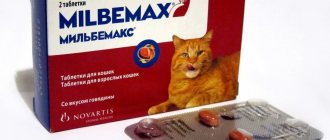05.11.2021 20 708 Diseases and treatment of cats
Author: Olga
Uncleanliness of an animal or external influences on it can not only cause the cat’s illness, but also its death. Therefore, all possible infections that a kitten may develop should be stopped in a timely manner. Now you will find out what distemper is in cats - what symptoms are characteristic of this infection, how a kitten is treated for this disease. You will also find photos and other useful information.
[Hide]
What is plague
In veterinary medicine there is the term “panleukopenia”, but most often this word is replaced by a popular synonym - distemper. This is an acute viral disease that affects all organs and systems. It is difficult to get sick at home, but if your pet goes outside, he is at risk.
The virus enters the blood and immediately begins its destructive effect. The digestive system is always the first to suffer. The virus then spreads and damages the lungs, heart and blood vessels. Then other systems and organs suffer, including the nervous system and skin.
© shutterstock
Vodka with vanillin against ticks
Ticks are a serious problem for summer residents. To repel ticks and mosquitoes, prepare a tincture of 100 ml of vodka and 2 g of vanillin. The product is infused for a week in a cool, dark place, and then poured into a spray bottle.
Before a walk, the hair on the dog’s belly, withers and paws is sprayed with vanilla tincture. When the fur is dry, the dog can be taken out.
Vanilla tincture does not provide a complete guarantee against insect bites; tar is more effective. But many owners prefer to use vanilla tincture, as it smells more pleasant than tar.
Your mark:
Forms of plague
Diagnosis of plague is carried out in the laboratory, but the disease can also be identified by its characteristic symptoms. Plague is divided into three forms .
- Lightning fast (super acute). Signs of distemper in kittens in most cases are attributed to the fulminant form of infection. It progresses very quickly, 8 out of 10 kittens die within a week.
- Spicy. Adult cats are susceptible to it. Animals from 6 years of age are at risk, when the immune system begins to work worse.
- Subacute. The vaccination given to prevent distemper does not always work. But if the virus enters the body of a cat that has undergone antiviral vaccination, the disease passes easily. With this form of the disease, a cat can get distemper at home.
Prevention
Plague is a disease with which you should not tempt fate. Veterinarians never tire of repeating: animals must be vaccinated! This procedure is very successful in protecting cats from this terrible disease.
The effects of the vaccine should theoretically last for 3 years, but doctors advise not to skimp on your health and to get vaccinated annually after a two-stage vaccination:
- 1 – at the age of 8 weeks.
- 2 – at the age of 12 weeks.
Do not forget that the causative agent of the virus is extremely tenacious; it can be carried on street shoes, objects, and belongings. Be especially attentive to animals taken from places where animals gather: markets, nurseries.
Main symptoms
Signs of infection are easy to notice, as the virus is very aggressive and attacks all types of cells. Diagnosis of the disease is not difficult. The following symptoms appear :
- uncontrolled vomiting, vomit is yellow, green, often with foam;
- liquid feces always accompanies this disease, stools have a green tint and are watery;
- general weakness, fatigue, apathy;
- the animal stops eating and drinking;
- cats often lie by a bowl of water, but cannot drink due to spasms in the throat;
- when the cardiovascular system is affected, tachycardia begins (rapid, irregular heartbeat);
- after a few days, due to the weakness of the blood vessels, blood is visible in the stool and vomit;
- the skin is fragile, wounds appear on it, in which pus is visible after some time;
- enlarged lymph nodes;
- the cat may become cowardly, the fur becomes sticky and wet;
- mucus flows profusely from the eyes and nose.
© shutterstock
If an animal is infected with distemper, it becomes inactive and lies around a lot. Dehydration is one of the symptoms of plague. If the cells of the nervous system are affected, the pet's behavior may resemble rabies: it hides from light, is frightened by any sounds, hides and reacts aggressively to stimuli.
Diagnostics, tests
When making a diagnosis, the veterinarian takes into account the medical history, clinical picture, results of ultrasound, CT, MRI, and the epizootological situation in the region. A number of serological, histological, and complex laboratory studies are carried out. For analysis, blood, stool, urine samples, tear secretions, eye and nasal secretions are taken.
Diagnostics includes PCR analysis, ELISA. Special tests are carried out. Due to the similarity of clinical manifestations, a differential diagnosis is mandatory, which makes it possible to establish an accurate diagnosis if panleukopenia is suspected in cats.
Treatment
Treatment of distemper in cats should be carried out under the close supervision of a veterinarian. If possible, contact a doctor who can competently draw up a treatment program for your pet. There is no cure for this disease, so treatment is aimed at relieving symptoms, preventing the virus from entering tissues, stimulating the immune system and directing it not to fight the virus.
Cats have a much stronger immune system than humans, so in half the cases they can overcome the infection. The virus lives in the body for some time, but no longer causes harm.
But it often happens that there is no way to see a veterinarian. Not all localities have clinics and not all the necessary medications are available. Then you have to help the pet yourself and treat distemper in cats at home.
Risk group
Clinically healthy animals under 6 years of age are least at risk of becoming infected with distemper, as statistics prove.
Over time, the protective functions of the animal’s body are depleted, which is why cats 6–8 years old are most often at risk of developing the disease. This group also includes young cats (up to 12 months) . At this time, the animal’s body is not yet strong. He cannot protect himself from the plague virus.
A cat infected during pregnancy produces nonviable offspring. Distemper can provoke fetal resorption, mummification and miscarriage.
Diagnosis of feline distemper
Only a veterinarian can diagnose the disease. Why is a cat's feces, urine and blood analyzed? Sometimes nasopharyngeal lavage is also examined. By the way, a stool test can show the presence of the virus already on the first day of infection. Therefore, when suspicions arise about a cat’s health, experts advise immediately contacting a veterinary clinic.
Vodka as a remedy against plague at home
There is no cure for distemper in cats, so often any means that in theory can work is used. This method of treatment really does not seem to be the most reliable and will raise doubts among skeptics, but practice shows that the method is effective. It often even happened that vodka helped cure a pet even in hopeless cases.
If the owner notices the onset of the disease on time, then you can try treatment at home. Usually the following mixture is prepared: 20 grams of regular vodka is mixed with one fresh egg yolk. The resulting medicine is given to the sick animal 2 times a day. Treatment of plague with vodka, as a rule, has a positive effect within a day of use.
© shutterstock
This method is applicable at home only if the disease has not reached an acute stage and has not had time to spread throughout the body. During treatment, the cat should be given plenty of saline solutions to prevent dehydration. In severe cases, the veterinarian prescribes IV drips to save your pet’s life and relieve intoxication.
Vodka for severe exhaustion
People who are very cold drink a glass of vodka to warm up. Under the influence of alcohol, a person begins to sweat. But the dog does not have sweat glands, so it makes no sense to give alcohol to a dog that has fallen into an ice hole or been in the cold for a long time.
However, if the animal is exhausted to such an extent that it is impossible to palpate the veins and give an injection, even experienced veterinarians advise giving a little vodka. Alcohol will speed up your heart rate and blood flow, making it easier for the doctor to find the vein.
Other types of illness
If plague affects the nervous system, the doctor should prescribe the following medications: Mydocalm or analogues - to reduce muscle tone, Pagluferal 2 for epilepsy, for weakness and partial paralysis - one percent Strychnine, in case of severe excitability - diphenhydramine with Aminazine ", benzonal, folic acid, sodium barbital. Intracranial pressure will help reduce 25% magnesium sulfate.
When skin lesions are caused by plague, blisters and crusts appear on the skin, which must be treated with an antiseptic ointment. To prevent your pet from scratching the sores and not licking the ointment, you will need to wear a protective collar. In severe cases, immunostimulants, antibiotics and vitamins are prescribed.
The dog fell ill with distemper. How to treat? Do not give your animal medicine from your first aid kit just in case it helps. All recommendations should only be given by a veterinarian. The article describes the remedies for informational purposes only; the doctor will prescribe the correct dosage and, possibly, other medications.
Causes of infection
Distemper is caused by a virus that is most dangerous for animals. It penetrates through the respiratory tract or orally.
The main source of infection is interaction with a sick animal; in this case, the dog emits the virus through saliva, urine or feces. If a dog is sick with distemper, then the virus is on all objects that came into contact with it, and these things need to be eliminated; the best way is to burn them. Do not throw away these items; they may cause infection to another animal. Never accept used items from a deceased dog as a gift, as they may carry a dangerous virus. Common causes of animal infection are:
- feeders;
- toys;
- beds;
- carrier bags;
- enclosures that have ever contained infected individuals.
If the dog is a pet and does not interact with other animals, this does not mean that it is safe. The cause of infection can even be ordinary dirt on a person’s shoes, brought home, clothes, or the remains of dirt on a dog’s paws after a walk.
The danger of infection occurs in early spring and late autumn, when above-zero temperatures are not as high as in summer. It is at this time of year that you need to especially protect your pet. So, how to treat distemper in a dog?
conclusions
Plague is definitely easier to prevent than to treat. Please love your pet and do not neglect vaccinations. Be sure to get vaccinated according to the schedule.
By the way, the clinic will offer you an imported or domestic vaccine. The first one is a little more expensive, but dogs tolerate it better. The second is cheaper, but also harder to learn. The nature of action of the drugs is the same. It makes no sense to get an additional distemper vaccination in isolation from others. As a rule, the necessary substance is already contained in the complex vaccine.
Attention: the above is for educational purposes only and does not constitute professional medical advice or scientific material.
Proper nutrition
Another additional method of prevention is organizing proper nutrition. Your pet's body will need strength to resist the virus, so take care of a balanced diet.
Your pet can get the required amount of protein every day not only from meat, but also from cottage cheese. The daily requirement of dietary vitamins is contained in raw liver, and the dog can get the required amount of iron from semolina. Millet is a source of nicotinic acid, buckwheat is a source of lecithin, etc. In general, food should be varied.
Good advice: do not use only ready-made mixtures and especially dry food in your dog’s diet. Along with ready-made store-bought delicacies, the animal should also receive regular cereals and stews. Such food has a positive effect on digestion. Don't forget about water, especially if dry food is present in the diet.
The course of coronavirus infection by day
Based on observations of those infected with COVID-19, a typical clinical picture of the pathology was established. The average duration of coronavirus infection is 13-22 days.
Please note that the first day of illness refers to the time of onset of symptoms, not the moment of infection.
What happens during this period:
- 1-4 days - the above first manifestations of the disease are observed, the temperature rises to febrile levels (more than 38°C), muscle pain is often present;
- 5-6 days - there is a feeling of lack of air, difficulty breathing, coughing attacks become longer;
- Day 7 - breathing problems intensify;
- 8-9 days - in severe cases, respiratory failure occurs, requiring oxygen support;
- 10-11 days - if the option is favorable, patients begin to recover, respiratory disorders are less pronounced;
- Day 12 - most patients experience a decrease in body temperature to normal;
- Days 13-22 - gradual recovery, normalization of all body functions.
Unlike other respiratory viral diseases, with the COVID-19 coronavirus, a runny nose is extremely rare. Also, this disease is not characterized by diarrhea and abdominal pain (no more than 4% of cases).
Which dogs are at risk for the disease?
Puppies and young dogs are most prone to this disease; the most dangerous period is considered to be from three months to one year. During this period of life, the animal’s teeth are replaced, the immune system becomes weak, and the body is exposed to various kinds of diseases. If the puppy is still being fed by its mother, then it is in little danger of distemper, because antibodies against this terrible disease enter the body with milk, but there are exceptions.
Dog breed has nothing to do with predisposition. Both a mongrel and a pedigree dog can get distemper. The peak incidence is noted in spring and autumn, and it is during these times of the year that every owner should know how to treat distemper in a dog. Providing first aid on time will speed up the recovery process and minimize the possibility of death of the animal.
Biology of the pathogen and epidemiological data
The causative agent of canine plague is an RNA virus belonging to the genus Morbilliviruses (family of Paramyxoviruses). This group also includes human measles viruses and rinderpest viruses. There are two viral proteins H and F on the surface of the chemical compound.
Protein H (hemagglutinin) with a molecular weight of 76 kDa performs the function of attachment to the so-called target cell. The protein has good variability, making it easily attached to different tissues.
The F (fusion) protein with a molecular weight of 62 kDa is responsible for the fusion of the affected cell and the virus, as well as the further spread of infected cells in the body.
It is noteworthy that the virus is resistant to external factors, especially in dried or frozen form. In this form, it can be active for 3-4 months. But if the environment is heated to 56°, then within 1.5 hours it will die. At 37-40°, the elimination of the virus occurs after 15 days. A 1% formaldehyde solution helps get rid of it in just 3 hours. A 2% NaOH solution can kill the disease in just 1 hour.
Dosage
You need to give her from 30 to 125 ml of vodka depending on her weight, puppies - 25-30 ml, large dogs - 100-125 ml. Vodka is poured into the mouth using a syringe (without a needle).
How to get drunk?
You need to raise the dog’s head, insert a syringe into the corner of the mouth and inject the contents; if everything is done correctly, the dog will swallow the medicine. If you manage to open your mouth, then apply it to the root of the tongue, but don’t press too hard, you can also get dislocated with the plague.
Treatment with vodka will be effective if the dog has good immunity and the disease is mild. In the case of an acute infection, you cannot do without a doctor and serious measures.
It is important to determine whether it is plague, it can be confused with enteritis, then vodka will not only not help, but will also aggravate the course of the disease.
“Belenkaya” has destructive properties against pathogenic bacteria, and its therapeutic effect is associated with this action.
Diet
We must not forget about special feeding during plague. Food should help boost immunity so that the body can fight harder:
- give more minced meat or finely chopped meat;
- raw egg - twice a week (during illness and during recovery);
- low-fat cottage cheese and kefir;
- broths from meat and vegetables are required; if you cook porridge, then make it liquid, like soup;
- A decoction of motherwort must be poured into drinking water during damage to the nervous system.











